Since we launched the Contributions Pilot last summer, thousands of users have helped out their favorite developers with small donations. We’ve continued to expand on the pilot with new features like Pledge Drives and subscriptions, and now we’re going to look at where users make their donations to authors.
There are quite a few places where users can see Contributions links on AMO:
- Add-on Detail page – The listing page for an add-on
- Home Page – Links on the home page to Contributions
- Meet the Developer – The “Meet the Developer” page that explains why an add-on was created and introduces the developer to users
- Roadblock – A version of the “Meet the Developer” page that a user needs to click through to download an add-on
- First Run Page – The First Run page allows developers to request contributions post-install with a version of the “Meet the Developer” page
- Browse pages – Contributions links on the pages used to browse categories, most downloaded, recommended, and top-rated add-ons
- Search – Contributions links on search results
Over the past 4 months, we’ve looked at the data we’ve gathered and found that add-ons users have given over $40,000 to the developers of their add-ons. Here’s a breakdown of the entire group of contributions:
The bulk of contributions come from the Add-on Detail pages, where users directly click on the “Contribute” buttons. First Run, Roadblock, and Meet The Developer all have similar slices at 9-12%. The remainder of sources make up a mere 9% total of overall revenue. From looking at this data it looks like Add-on Detail pages are where users are most likely to make a decision to contribute– but the data looks different when we divide the group into different cohorts, based on how authors ask for contributions.
When add-on developers ask for contributions from their users, they have three options for presenting this offer:
- Only when users click a “Contribute” link
- In the background while an add-on is downloaded
- As a roadblock when users click “Download”
Authors who don’t prompt for Contributions make up the largest group:
About half of all participating add-ons elected to go with the least obtrusive option. Unsurprisingly, over three quarters of contributions come from the main “Add-on Detail” page.
Let’s look at the second group of authors who show the “Meet the Developer” page during add-on download:
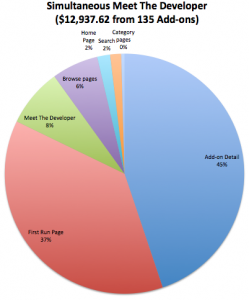 Here’s where things start to get interesting. This is the only group that elected to use a First Run page in any significant degree, and as you can see, the First Run page links generated 37% of the revenue in this group. Since this is currently the only way to reach users post-install, it is unsurprising that it does so well in comparison.
Here’s where things start to get interesting. This is the only group that elected to use a First Run page in any significant degree, and as you can see, the First Run page links generated 37% of the revenue in this group. Since this is currently the only way to reach users post-install, it is unsurprising that it does so well in comparison.
The last group has chosen to interrupt the download process with a “Meet the Developer” page:
Unsurprisingly, the roadblock generates the majority of revenue for this cohort. This is where the mix of contributions sources differ significantly than the first group. While the revenue per add-on in this group is also lower than the other two, it’s important to take into consideration the relative popularity of add-ons in these three groups:
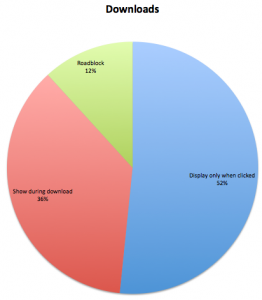 Roadblocked add-ons only represent 12% of the total downloads of Add-ons that request contributions. This group is only about one-fifth as large as the no-roadblock, no-display-while-downloading group. Let’s look at how revenue splits in these groups:
Roadblocked add-ons only represent 12% of the total downloads of Add-ons that request contributions. This group is only about one-fifth as large as the no-roadblock, no-display-while-downloading group. Let’s look at how revenue splits in these groups:
As you can see here, the roadblocked add-ons comprise 18% of overall revenue while only representing 12% of overall downloads. The middle group seems to be doing somewhat worse, with 38% of the downloads only garnering 30% of overall contributions.
While this is far from a scientific study, it appears that add-ons that employ a roadblock in concert with a well written “Meet the Developer” page receive the highest revenue per download. Also note that the First Run pages seem to work very well for developers that elect to use them. Based on this observation, we believe that adding a First Run page can have a significant impact on donations from users.
If you’re an author who uses Contributions to sustain the development of your add-on, we hope this information helps you refine your approach with our Contributions pilot.
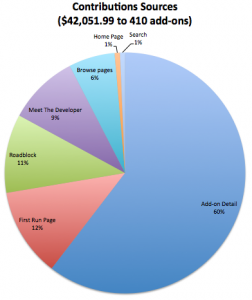
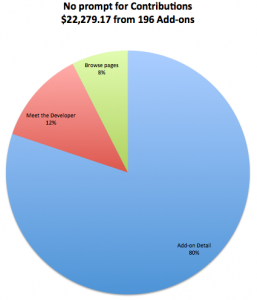
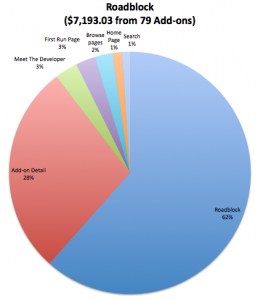

Brett Zamir wrote on
wrote on
Ken Saunders wrote on
wrote on
Nick Nguyen (osunick) wrote on
wrote on
Nick Nguyen (osunick) wrote on
wrote on
zigboom wrote on
wrote on